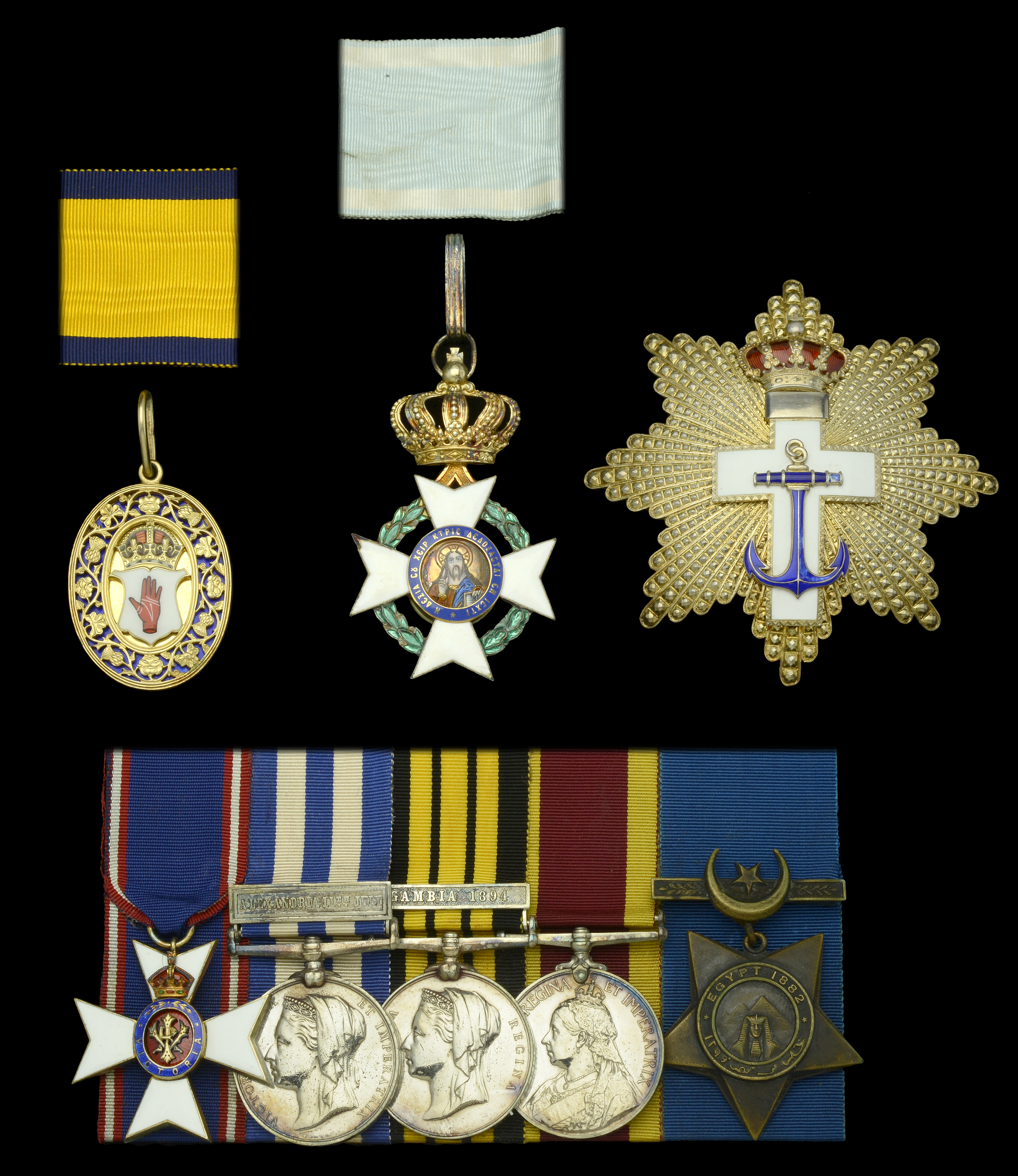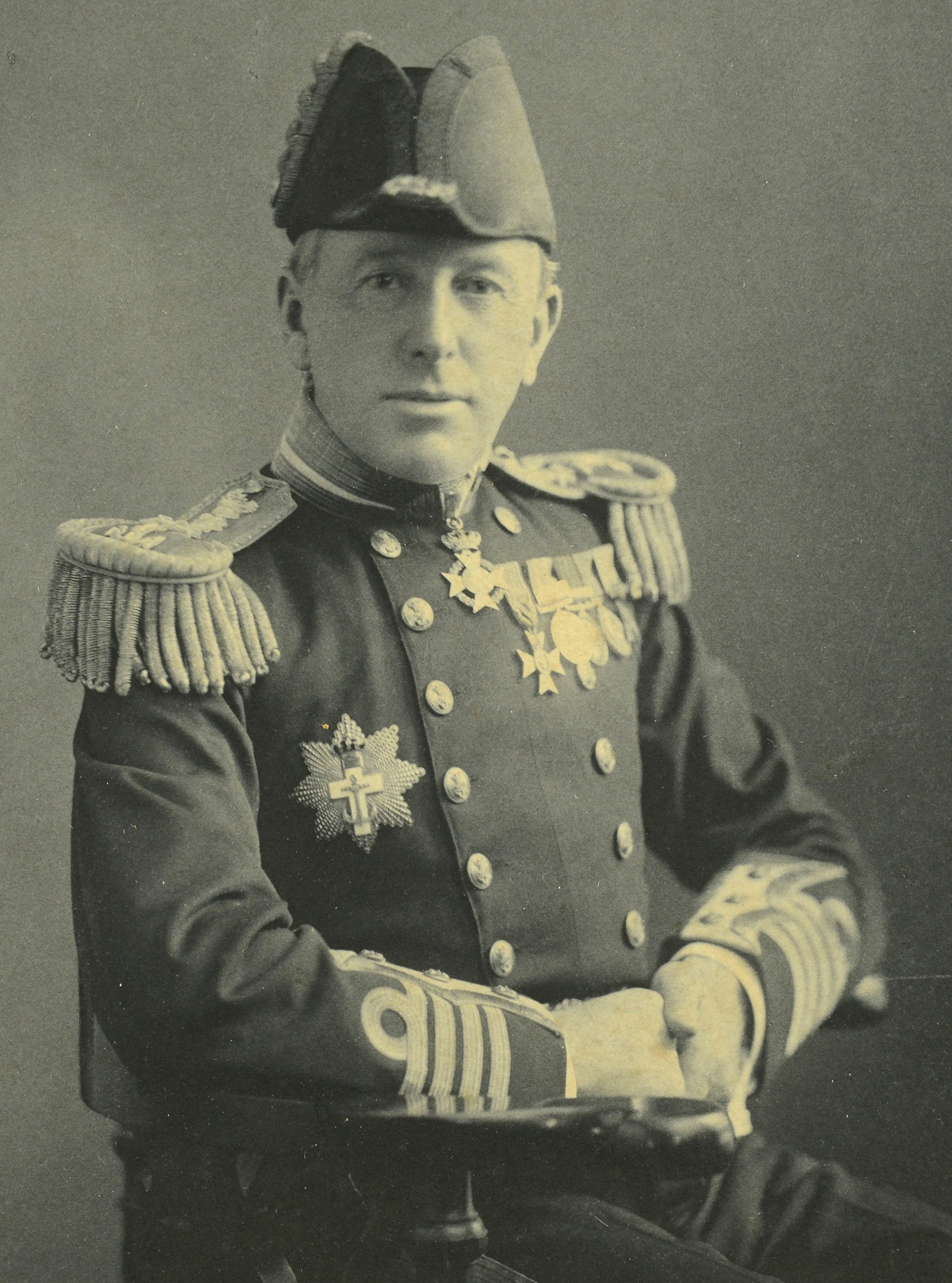The Baronet’s Badge and M.V.O. group of eight awarded to Rear-Admiral Sir Charles Graves-Sawle, Bt., Royal Navy, who was mentioned in despatches for his command of the Naval Brigade in the Gambia in 1894, which role he assumed after Flag Captain E. H. Gamble had been wounded Baronet’s Badge, of the United Kingdom, silver-gilt and enamels, the reverse inscribed ‘Graves-Sawle of Penrice 1836’, hallmarked London 1929; The Royal Victorian Order, M.V.O., Member’s 4th Class breast badge, silver-gilt and enamels, the reverse officially numbered ‘110’; Egypt and Sudan 1882-89, dated reverse, 1 clasp, Alexandria 11th July (Lieut: C. J. Graves-Sawle. R.N. H.M.S. “Superb”); East and West Africa 1887-1900, 1 clasp, Gambia 1894 (Commr. C. G. Sawle R.N., H.M.S. Raleigh.); China 1900, no clasp (Captain C. J. Graves-Sawle, R.N. H.M.S. Bonaventure.); Khedive’s Star, dated 1882; Greece, Kingdom, Order of the Redeemer, 3rd Class neck badge, silver-gilt and enamels, with neck cravat in its Lemaitre, Paris case of issue; Spain, Kingdom, Order of Naval Merit, 2nd Class breast star, silver-gilt and enamels, some enamel chips to the last two, otherwise nearly very fine or better (8) £3,000-£4,000 --- Importation Duty This lot is subject to importation duty of 5% on the hammer price unless exported outside the UK --- --- Provenance: Alan Hall Collection, June 2000. M.V.O. London Gazette 2 June 1903: ‘The King has been graciously pleased, during His Majesty’s visit to Malta, to make the following appointments to the Royal Victorian Order.’ Charles John Graves-Sawle was born on 28 April 1851, the second son of Sir Charles Brune Graves-Sawle, 2nd Baronet, and Member of Parliament for Bodmin. His grandfather took the additional name of Sawle, having inherited the estates of that ancient Cornish family at Penrice. Charles’s descendants numbered Rear-Admiral Thomas Graves, who led the van at the ‘Glorious First of June’ in 1794’ and Sir Thomas Graves, Vice-Admiral of the Blue and second-in-command to Nelson at Copenhagen. And he continued his family’s naval tradition, after attending Somerset College, Bath. His obituary in The Times, published on 19 February 1932, takes up the story: ‘He entered the Royal Navy in March 1865. He served in the Hercules and Bellerophon and was promoted to Lieutenant in April 1876. He went to the Mediterranean in October 1880 as Lieutenant of the Superb and served there about six years. He was present at the bombardment of Alexandria in July 1882 and during the operations of the Egyptian War, for which he received the Medal with clasp ‘Alexandria 11th July’ and the Khedive’s Bronze Star. In 1888 he became Second in Command of the Canada on the North American Station. He was appointed in January 1890 as First Lieutenant of the battleship Anson, Flagship of Rear-Admiral Tracey in the Channel Squadron and was promoted to Commander in December 1890. The following summer he went to the Cape as Commander of Raleigh, Flagship of the Commander in Chief Rear-Admiral Sir Frederick Bedford, K.C.B. It fell to the Rear-Admiral to conduct certain punitive expeditions in West Africa in one of which Commander Graves-Sawle took a prominent part. After Flag Captain Gamble had been wounded he took command of the Naval Brigade landed from Raleigh, Alecto, Satellite, Magpie and Widgeon at Bathurst, on the River Gambia, in February 1894, in co-operation with two companies of the 1st West India Regiment, to punish a rebellious slave trading chief named Fodi Silah. For his services he was Mentioned in Despatches and received the General Africa Medal with clasp ‘Gambia 1894’. In the following August he received his first independent command, the light cruiser Mohawk, in North American waters and in December 1896 he was promoted to Captain His first service as Captain was as Flag Captain to Vice-Admiral Sir Frederick Bedford in Crescent, on the North American Station. In 1900 he went to China as Captain of the Bonaventure. As Captain of the cruiser Aboukir in the Mediterranean on the occasion of King Edward’s visit to Malta in 1903 he was made an M.V.O. Following his father’s death in April 1903, and the death of his brother without issue in August of the same year, he succeeded to the Baronetcy and property. He did not seek another appointment and retired. He was A.D.C. to King Edward VII in 1906 and was advanced to Rear-Admiral on the Retired List in 1907. He became High Sheriff of Cornwall in 1913. He died on 18 February 1932. Sir Charles married in 1887 Constance Mary, daughter of General C. F. T. Daniell, and had one son in the Coldstream Guards who was killed at Ypres, and two daughters, one of whom died in 1926; the other is the wife of Colonel R. P. Cobbold. The Baronetcy becomes extinct.’ Sold with a fine array of card-mounted studio portrait photographs, approximately 15 images of which half are contained in a photographer’s proof portfolio, together with copied research.









